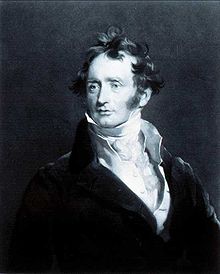Robert Gilmor
Robert Gilmor Jr. (Born September 24, 1774 in Saint Mary's County , Maryland , † November 30, 1848 in Baltimore ) was an American shipowner , art collector and patron .
Life
Robert Gilmor Jr. was the heir of the wealthy, Scottish-born shipowner Robert Gilmor (1748–1822), whose business his son continued to expand into a profitable shipping company. As an art lover and connoisseur, he put together an extensive collection of important art objects, including above all paintings by old European masters, sculptures, manuscripts and other objects. In addition, his main interests were in contemporary art in the USA, where he was one of the main patrons of national art in the first half of the 19th century. Like other contemporaries, he saw it as his duty to promote the country's art. As a friend of early landscape painting, Gilmor mainly supported Thomas Doughty , William Goombridge , Francis Guy and Thomas Cole through commissions and the purchase of paintings, and he was also in social contact with many artists. The other landscape painters he supported included Robert W. Weir , William Dunlap , Charles Willson Peale , Thomas Sully , Henry Inman , John Wesley Jarvis and John Trumbull , as well as history painters such as Washington Allston , John Gadsby Chapman , Charles Cromwell Ingham and William Sidney Mount and the portrait painter Gilbert Stuart . By commissioning Horatio Greenough , he also tried to promote American sculpture.
In 1844 Gilmor was criticized by an article in the New York Herold like many other art sponsors for hiding their collections from other artists and interested parties. Gilmor became a symbol of traditional aristocratically oriented collectors and patrons who should not have paid the artists fair prices and should have restricted them in their artistic work. Bourgeois collectors such as Benjamin Coleman Wards in particular were contrasted with him as positive examples of collectors. Gilmor resisted these claims and hoped for further support, which was not given. Subsequent investigations of existing records actually showed that Gilmor paid the artists high prices and made no rules whatsoever for the subject they painted - the allegations were therefore only partially true and his protest justified.
During his life he owned around 500 paintings and 2,500 drawings and graphics, some of which he traded or exchanged for other art objects. However, his collection always consisted of at least 300 to 400 paintings in his own possession. In two auctions after his death (on November 10, 1863 and April 13, 1875) the collection was dissolved and sold to various collectors.
Gilmor's marriage to Sarah Reeve was childless.
literature
- Stephan Koja (Hrsg.): America - The new world in pictures of the 19th century. Prestel Verlag, Munich 1999; Page 195. ISBN 3-7913-2051-3
Web links
- Alan Walach: Gilmor, Robert Jr. Grove Art Online. Oxford University Press; http://www.groveart.com/ (registration required)
| personal data | |
|---|---|
| SURNAME | Gilmor, Robert |
| ALTERNATIVE NAMES | Gilmor, Robert Jr. |
| BRIEF DESCRIPTION | American shipowner, art collector and patron |
| DATE OF BIRTH | September 24, 1774 |
| PLACE OF BIRTH | Saint Mary's County |
| DATE OF DEATH | November 30, 1848 |
| Place of death | Baltimore |
